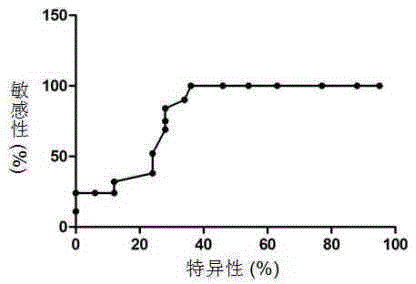Non-small cell lung cancer marker, detection reagent and kit
A non-small cell lung cancer, detection kit technology, applied in the field of molecular biology, can solve the problems of patients losing surgically resected lesions, unsatisfactory detection sensitivity and specificity, and inconspicuous early symptoms of lung cancer. Sensitivity and specificity, easily detectable effects
- Summary
- Abstract
- Description
- Claims
- Application Information
AI Technical Summary
Problems solved by technology
Method used
Image
Examples
Embodiment 1
[0058] Example 1 Screening of miRNAs associated with human lung cancer
[0059] 1.1 Collection of samples and collation of data
[0060] The inventor collected a large number of peripheral blood samples from lung cancer patients, pneumonia patients and healthy individuals in the Affiliated Hospital of Wenzhou Medical University in November 2014 (sample collection, pretreatment, subpackaging, storage conditions, etc. of different batches are consistent) , through sorting out the sample data, the inventor selected 30 cases of plasma from patients with non-small cell lung cancer randomly collected in the same hospital and as far as possible in the same department, 20 cases of plasma from patients with pneumonia randomly collected in the same hospital and the same period as the experimental group, and 40 cases of plasma from the same hospital and the experimental group. Plasma samples from healthy individuals randomly collected from the same period as the experimental group (inclu...
Embodiment 2
[0082] Example 2 QPCR verification of differentially expressed miRNA-375
[0083] According to the detection results of the miRNA chip above, miRNA-375 was selected for QPCR verification of a larger number of samples. 95 samples from the non-small cell lung cancer group and 120 samples from the healthy group were selected according to the method of sample collection and sample data arrangement in Example 1.
[0084] 2.1 The extraction process of total RNA is the same as in Example 1.
[0085] 2.2 Reverse transcription: mix 10pg-1μg total RNA template with 2μl 5* buffer, 1μl genomic DNA digesting enzyme and RNase-free water (RNase-free water) to a final volume of 10μl, incubate at 42°C for 5min Genomic DNA is removed. Then add 0.5 μl of 20 μM specific reverse transcription primer to the reaction tube, incubate at 65°C for 10 minutes and immediately incubate on ice for at least 2 minutes to break the secondary structure of RNA and primers. Finally, mix the above reaction mixt...
Embodiment 3
[0087] Example 3 Analysis of the prediction of exosome-derived miRNA on the incidence of non-small cell lung cancer
[0088] Exosome-derived miRNA-375 was used as the research object and compared with plasma free miRNA in terms of sensitivity and specificity in distinguishing control and lung cancer groups. Taking patients with non-small cell lung cancer as the experimental group, and patients with pneumonia and normal people as the control group, firstly use the total exosome isolation reagent (Invitrogen) to extract the exosomes in the plasma (the steps are basically the same as in Example 1). 40 non-small cell lung cancer plasma samples, 20 pneumonia patients, and 40 normal human plasma samples were selected for exosomal miRNA-375 (exosome group) and plasma free miRNA-375 (plasma group) QPCR experiments (method basic Same as Example 2, but the plasma group is directly extracting free miRNA-375 instead of separating from exosomes), and the CT value of each specimen is obtain...
PUM
 Login to View More
Login to View More Abstract
Description
Claims
Application Information
 Login to View More
Login to View More - R&D Engineer
- R&D Manager
- IP Professional
- Industry Leading Data Capabilities
- Powerful AI technology
- Patent DNA Extraction
Browse by: Latest US Patents, China's latest patents, Technical Efficacy Thesaurus, Application Domain, Technology Topic, Popular Technical Reports.
© 2024 PatSnap. All rights reserved.Legal|Privacy policy|Modern Slavery Act Transparency Statement|Sitemap|About US| Contact US: help@patsnap.com










